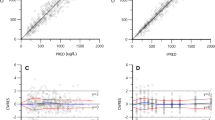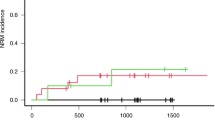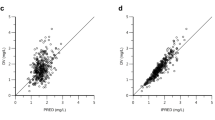Abstract
Purpose
To build a population pharmacokinetic (PK) model of cyclophosphamide (CY) and its metabolite, 4-hydroxycyclophosphamide (HCY), in patients undergoing allogeneic haematopoietic stem cell transplantation (HSCT) and to identify covariates, including genetic polymorphisms, which affect CY and HCY PK parameters.
Method
The study cohort comprised 21 patients undergoing HSCT who received CY intravenously between 2009 and 2011. Clinical characteristics and CY and HCY concentration data were collected for all patients, and ABCB1, ABCC2, GSTA1, GSTM1, GSTP1, GSTT1, CYP2B6, CYP2C19, and CYP3A5 genotyping was performed. A hypothetical enzyme compartment was conducted using the NONMEM program.
Results
A population PK analysis showed that the ABCC2 1249 genotype and aspartate aminotransferase levels significantly affected non-induced clearance (CL UI) and induced clearance (CL I) of CY, respectively. The final estimate of the mean CL UI and CL I of CY was 15.5 and 0.683 L/h, respectively, and the mean volume of distribution (V 1) of CY was 88.0 L. The inter-individual variability for CL UI, CL I, and V 1 of CY was 52.8, 200, and 18.0 %, respectively. Additionally, the CL UI of CY was significantly decreased to approximately 51 % in patients with the 1249 GA heterozygous genotype compared to those with the 1249 GG wild-type genotype (p < 0.05). There were only three heterozygous GA variants of ABCC2 1249 in the study patients.
Conclusions
The population PK model developed in this study implies an influence of genetic factors on the clearance of CY. Clearance was moderately reduced in patients with the ABCC2 1249GA heterozygous genotype.


Similar content being viewed by others
References
van der Wall E, Beijnen JH, Rodenhuis S (1995) High-dose chemotherapy regimens for solid tumors. Cancer Treat Rev 21(2):105–132
Timm R, Kaiser R, Lotsch J, Heider U, Sezer O, Weisz K, Montemurro M, Roots I, Cascorbi I (2005) Association of cyclophosphamide pharmacokinetics to polymorphic cytochrome P450 2C19. Pharmacogenomics J 5(6):365–373
Rocha V, Franco RF, Porcher R, Bittencourt H, Silva WA Jr, Latouche A, Devergie A, Esperou H, Ribaud P, Socie G, Zago MA, Gluckman E (2002) Host defense and inflammatory gene polymorphisms are associated with outcomes after HLA-identical sibling bone marrow transplantation. Blood 100(12):3908–3918
Socie G, Loiseau P, Tamouza R, Janin A, Busson M, Gluckman E, Charron D (2001) Both genetic and clinical factors predict the development of graft-versus-host disease after allogeneic hematopoietic stem cell transplantation. Transplantation 72(4):699–706
Chang TK, Weber GF, Crespi CL, Waxman DJ (1993) Differential activation of cyclophosphamide and ifosphamide by cytochromes P-450 2B and 3A in human liver microsomes. Cancer Res 53(23):5629–5637
Chang TK, Yu L, Goldstein JA, Waxman DJ (1997) Identification of the polymorphically expressed CYP2C19 and the wild-type CYP2C9-ILE359 allele as low-Km catalysts of cyclophosphamide and ifosfamide activation. Pharmacogenetics 7(3):211–221
Bohnenstengel F, Hofmann U, Eichelbaum M, Kroemer HK (1996) Characterization of the cytochrome P450 involved in side-chain oxidation of cyclophosphamide in humans. Eur J Clin Pharmacol 51(3–4):297–301
Ren S, Yang JS, Kalhorn TF, Slattery JT (1997) Oxidation of cyclophosphamide to 4-hydroxycyclophosphamide and deschloroethylcyclophosphamide in human liver microsomes. Cancer Res 57(19):4229–4235
Dockham PA, Lee MO, Sladek NE (1992) Identification of human liver aldehyde dehydrogenases that catalyze the oxidation of aldophosphamide and retinaldehyde. Biochem Pharmacol 43(11):2453–2469
McCune JS, Salinger DH, Vicini P, Oglesby C, Blough DK, Park JR (2009) Population pharmacokinetics of cyclophosphamide and metabolites in children with neuroblastoma: a report from the Children’s Oncology Group. J Clin Pharmacol 49(1):88–102
de Jonge ME, Huitema AD, van Dam SM, Rodenhuis S, Beijnen JH (2005) Population pharmacokinetics of cyclophosphamide and its metabolites 4-hydroxycyclophosphamide, 2-dechloroethylcyclophosphamide, and phosphoramide mustard in a high-dose combination with Thiotepa and Carboplatin. Ther Drug Monit 27(6):756–765
Graham MI, Shaw IC, Souhami RL, Sidau B, Harper PG, McLean AE (1983) Decreased plasma half-life of cyclophosphamide during repeated high-dose administration. Cancer Chemother Pharmacol 10(3):192–193
Moore MJ, Hardy RW, Thiessen JJ, Soldin SJ, Erlichman C (1988) Rapid development of enhanced clearance after high-dose cyclophosphamide. Clin Pharmacol Ther 44(6):622–628
Brock N, Stekar J, Pohl J, Niemeyer U, Scheffler G (1979) Acrolein, the causative factor of urotoxic side-effects of cyclophosphamide, ifosfamide, trofosfamide and sufosfamide. Arzneimittelforschung 29(4):659–661
McDonald GB, Sharma P, Matthews DE, Shulman HM, Thomas ED (1984) Venocclusive disease of the liver after bone marrow transplantation: diagnosis, incidence, and predisposing factors. Hepatology 4(1):116–122
de Jonge ME, Huitema AD, Rodenhuis S, Beijnen JH (2005) Clinical pharmacokinetics of cyclophosphamide. Clin Pharmacokinet 44(11):1135–1164
McDonald GB, Slattery JT, Bouvier ME, Ren S, Batchelder AL, Kalhorn TF, Schoch HG, Anasetti C, Gooley T (2003) Cyclophosphamide metabolism, liver toxicity, and mortality following hematopoietic stem cell transplantation. Blood 101(5):2043–2048
Balasubramanian P, Desire S, Panetta JC, Lakshmi KM, Mathews V, George B, Viswabandya A, Chandy M, Krishnamoorthy R, Srivastava A (2012) Population pharmacokinetics of cyclophosphamide in patients with thalassemia major undergoing HSCT. Bone Marrow Transplant 47(9):1178–1185
Nakajima M, Komagata S, Fujiki Y, Kanada Y, Ebi H, Itoh K, Mukai H, Yokoi T, Minami H (2007) Genetic polymorphisms of CYP2B6 affect the pharmacokinetics/pharmacodynamics of cyclophosphamide in Japanese cancer patients. Pharmacogenet Genomics 17(6):431–445
Rossi D, Rasi S, Franceschetti S, Capello D, Castelli A, De Paoli L, Ramponi A, Chiappella A, Pogliani EM, Vitolo U, Kwee I, Bertoni F, Conconi A, Gaidano G (2009) Analysis of the host pharmacogenetic background for prediction of outcome and toxicity in diffuse large B-cell lymphoma treated with R-CHOP21. Leukemia 23(6):1118–1126
Dasgupta RK, Adamson PJ, Davies FE, Rollinson S, Roddam PL, Ashcroft AJ, Dring AM, Fenton JA, Child JA, Allan JM, Morgan GJ (2003) Polymorphic variation in GSTP1 modulates outcome following therapy for multiple myeloma. Blood 102(7):2345–2350
Hohaus S, Di Ruscio A, Di Febo A, Massini G, D’Alo F, Guidi F, Mansueto G, Voso MT, Leone G (2005) Glutathione S-transferase P1 genotype and prognosis in Hodgkin’s lymphoma. Clin Cancer Res 11(6):2175–2179
Stanulla M, Schrappe M, Brechlin AM, Zimmermann M, Welte K (2000) Polymorphisms within glutathione S-transferase genes (GSTM1, GSTT1, GSTP1) and risk of relapse in childhood B-cell precursor acute lymphoblastic leukemia: a case–control study. Blood 95(4):1222–1228
Yang G, Shu XO, Ruan ZX, Cai QY, Jin F, Gao YT, Zheng W (2005) Genetic polymorphisms in glutathione-S-transferase genes (GSTM1, GSTT1, GSTP1) and survival after chemotherapy for invasive breast carcinoma. Cancer 103(1):52–58
Ekhart C, Doodeman VD, Rodenhuis S, Smits PH, Beijnen JH, Huitema AD (2008) Influence of polymorphisms of drug metabolizing enzymes (CYP2B6, CYP2C9, CYP2C19, CYP3A4, CYP3A5, GSTA1, GSTP1, ALDH1A1 and ALDH3A1) on the pharmacokinetics of cyclophosphamide and 4-hydroxycyclophosphamide. Pharmacogenet Genomics 18(6):515–523
Qiu R, Yao A, Vicini P, McDonald GB, Batchelder AL, Bouvier ME, Cole SL, Slattery JT (2004) Diminishing the risk of nonrelapse mortality in hematopoietic stem cell transplantation: Prediction of exposure to the cyclophosphamide metabolite carboxyethylphosphoramide mustard. Clin Pharmacol Ther 76(3):270–280
Vesell ES (1977) Genetic and environmental factors affecting drug disposition in man. Clin Pharmacol Ther 22(5 Pt 2):659–679
World Medical Association (2008) WMA Declaration of Helsinki—Ethical principles for medical research involving human subjects (2002). At: 59th WMA General Assembly. Seoul. Available (pdf file) at: http://www.wma.net/en/30publications/10policies/b3/
Ekhart C, Gebretensae A, Rosing H, Rodenhuis S, Beijnen JH, Huitema AD (2007) Simultaneous quantification of cyclophosphamide and its active metabolite 4-hydroxycyclophosphamide in human plasma by high-performance liquid chromatography coupled with electrospray ionization tandem mass spectrometry (LC-MS/MS). J Chromatogr B Analyt Technol Biomed Life Sci 854(1–2):345–349
Cockcroft DW, Gault MH (1976) Prediction of creatinine clearance from serum creatinine. Nephron 16(1):31–41
Beal S, Sheiner L, Boeckmann A, Bauer R (2009) NONMEM user’s guides 1989–2009. Icon Development Solutions, Dublin
Jonsson EN, Karlsson MO (1999) Xpose–an S-PLUS based population pharmacokinetic/pharmacodynamic model building aid for NONMEM. Comput Methods Programs Biomed 58(1):51–64
Lindbom L, Ribbing J, Jonsson EN (2004) Perl-speaks-NONMEM (PsN)–a Perl module for NONMEM related programming. Comput Methods Programs Biomed 75(2):85–94
Keizer RJ, van Benten M, Beijnen JH, Schellens JH, Huitema AD (2011) Pirana and PCluster: a modeling environment and cluster infrastructure for NONMEM. Comput Methods Programs Biomed 101(1):72–79
Huitema AD, Mathot RA, Tibben MM, Rodenhuis S, Beijnen JH (2001) A mechanism-based pharmacokinetic model for the cytochrome P450 drug-drug interaction between cyclophosphamide and thioTEPA and the autoinduction of cyclophosphamide. J Pharmacokinet Pharmacodyn 28(3):211–230
Hassan M, Svensson US, Ljungman P, Bjorkstrand B, Olsson H, Bielenstein M, Abdel-Rehim M, Nilsson C, Johansson M, Karlsson MO (1999) A mechanism-based pharmacokinetic-enzyme model for cyclophosphamide autoinduction in breast cancer patients. Br J Clin Pharmacol 48(5):669–677
Kumar S, Wolf RC, Chen MG, Gastineau DA, Gertz MA, Inwards DJ, Lacy MQ, Tefferi A, Litzow MR (2002) Omission of day +11 methotrexate after allogeneic bone marrow transplantation is associated with increased risk of severe acute graft-versus-host disease. Bone Marrow Transplant 30(3):161–165
Choi SW, Levine JE, Ferrara JL (2010) Pathogenesis and management of graft-versus-host disease. Immunol Allergy Clin North Am 30(1):75–101
Hill GR, Ferrara JL (2000) The primacy of the gastrointestinal tract as a target organ of acute graft-versus-host disease: rationale for the use of cytokine shields in allogeneic bone marrow transplantation. Blood 95(9):2754–2759
Johansson JE, Brune M, Ekman T (2001) The gut mucosa barrier is preserved during allogeneic, haemopoietic stem cell transplantation with reduced intensity conditioning. Bone Marrow Transplant 28(8):737–742
Salinger DH, McCune JS, Ren AG, Shen DD, Slattery JT, Phillips B, McDonald GB, Vicini P (2006) Real-time dose adjustment of cyclophosphamide in a preparative regimen for hematopoietic cell transplant: a Bayesian pharmacokinetic approach. Clin Cancer Res 12(16):4888–4898
Qiu R, Kalhorn TF, Slattery JT (2004) ABCC2-mediated biliary transport of 4-glutathionylcyclophosphamide and its contribution to elimination of 4-hydroxycyclophosphamide in rat. J Pharmacol Exp Ther 308(3):1204–1212
Zhang WX, Chen B, Jin Z, Yu Z, Wang X, Chen H, Mao A, Cai W (2008) Influence of uridine diphosphate (UDP)-glucuronosyltransferases and ABCC2 genetic polymorphisms on the pharmacokinetics of mycophenolic acid and its metabolites in Chinese renal transplant recipients. Xenobiotica 38(11):1422–1436
Fujita K, Nagashima F, Yamamoto W, Endo H, Sunakawa Y, Yamashita K, Ishida H, Mizuno K, Matsunaga M, Araki K, Tanaka R, Ichikawa W, Miya T, Narabayashi M, Akiyama Y, Kawara K, Ando Y, Sasaki Y (2008) Association of ATP-binding cassette, sub-family C, number 2 (ABCC2) genotype with pharmacokinetics of irinotecan in Japanese patients with metastatic colorectal cancer treated with irinotecan plus infusional 5-fluorouracil/leucovorin (FOLFIRI). Biol Pharm Bull 31(11):2137–2142
Lai Y, Xing L, Poda GI, Hu Y (2007) Structure-activity relationships for interaction with multidrug resistance protein 2 (ABCC2/MRP2): the role of torsion angle for a series of biphenyl-substituted heterocycles. Drug Metab Dispos 35(6):937–945
Ito K (2008) ABCC2/Abcc2 transport property in different species and its modulation by heterogeneous factors. Drug Metab Pharmacokinet 23(6):394–405
Chen TL, Kennedy MJ, Anderson LW, Kiraly SB, Black KC, Colvin OM, Grochow LB (1997) Nonlinear pharmacokinetics of cyclophosphamide and 4-hydroxycyclophosphamide/aldophosphamide in patients with metastatic breast cancer receiving high-dose chemotherapy followed by autologous bone marrow transplantation. Drug Metab Dispos 25(5):544–551
Beckett GJ, Foster GR, Hussey AJ, Oliveira DB, Donovan JW, Prescott LF, Proudfoot AT (1989) Plasma glutathione S-transferase and F protein are more sensitive than alanine aminotransferase as markers of paracetamol (acetaminophen)-induced liver damage. Clin Chem 35(11):2186–2189
Bagley CM Jr, Bostick FW, DeVita VT Jr (1973) Clinical pharmacology of cyclophosphamide. Cancer Res 33(2):226–233
De Bruijn EA, Slee PH, Van Oosterom AT, Lameijer DW, Roozendaal KJ, Tjaden UR (1988) Pharmacokinetics of intravenous and oral cyclophosphamide in the presence of methotrexate and fluorouracil. Pharm Weekbl Sci 10(5):200–206
Xie H, Griskevicius L, Stahle L, Hassan Z, Yasar U, Rane A, Broberg U, Kimby E, Hassan M (2006) Pharmacogenetics of cyclophosphamide in patients with hematological malignancies. Eur J Pharm Sci 27(1):54–61
Ljungman P, Hassan M, Bekassy AN, Ringden O, Oberg G (1997) High busulfan concentrations are associated with increased transplant-related mortality in allogeneic bone marrow transplant patients. Bone Marrow Transplant 20(11):909–913
Slattery JT, Sanders JE, Buckner CD, Schaffer RL, Lambert KW, Langer FP, Anasetti C, Bensinger WI, Fisher LD, Appelbaum FR et al (1995) Graft-rejection and toxicity following bone marrow transplantation in relation to busulfan pharmacokinetics. Bone Marrow Transplant 16(1):31–42
Acknowledgments
This work was supported by the National Research Foundation of Korea (NRF) grant funded by the Korea government (MEST) (No. 2012-0000185).
Conflict of interest
None.
Author information
Authors and Affiliations
Corresponding author
Electronic supplementary material
Below is the link to the electronic supplementary material.
ESM 1
(DOCX 210 kb)
Rights and permissions
About this article
Cite this article
Kim, IW., Yun, Hy., Choi, B. et al. Population pharmacokinetics analysis of cyclophosphamide with genetic effects in patients undergoing hematopoietic stem cell transplantation. Eur J Clin Pharmacol 69, 1543–1551 (2013). https://doi.org/10.1007/s00228-013-1507-7
Received:
Accepted:
Published:
Issue Date:
DOI: https://doi.org/10.1007/s00228-013-1507-7




